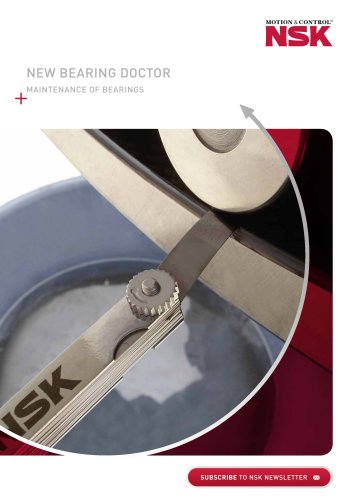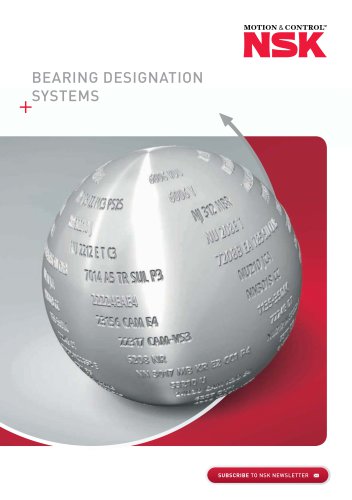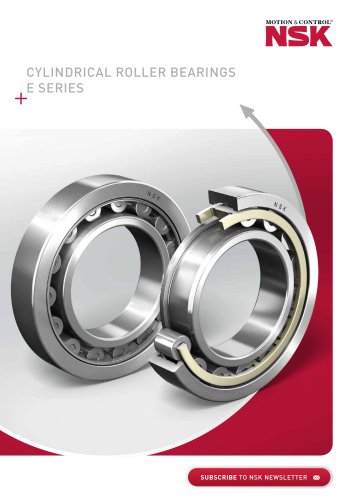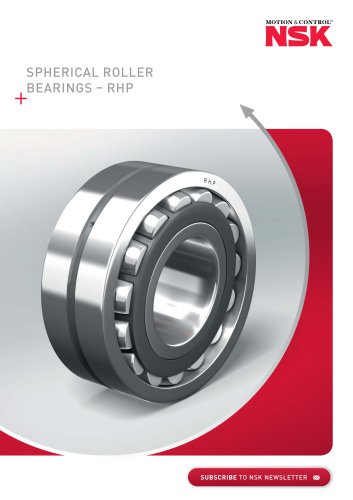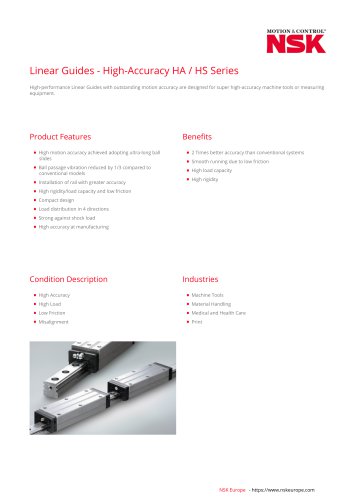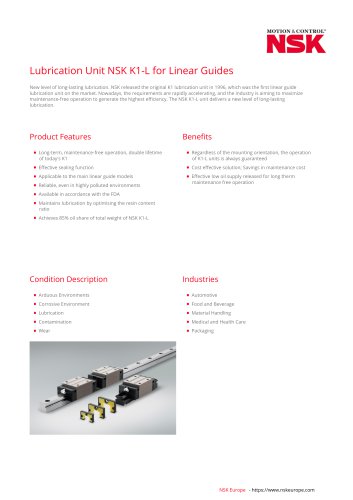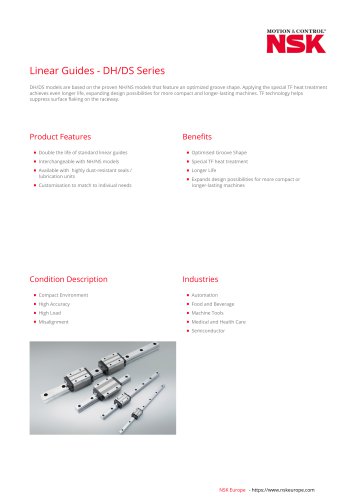
Catalog excerpts
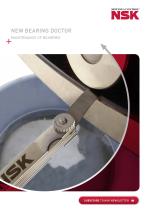
NEW BEARING DOCTOR MAINTENANCE OF BEARINGS
Open the catalog to page 1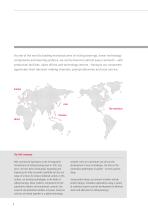
As one of the world’s leading manufacturers of rolling bearings, linear technology components and steering systems, we can be found on almost every continent – with production facilities, sales offices and technology centres – because our customers appreciate short decision-making channels, prompt deliveries and local service. Asia The Americas Oceania Africa The NSK company NSK commenced operations as the first Japanese manufacturer of rolling bearings back in 1916. Ever since, we have been continuously expanding and improving not only our product portfolio but also our range of services...
Open the catalog to page 2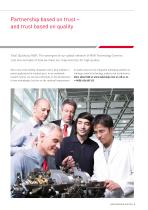
Partnership based on trust – and trust based on quality Total Quality by NSK: The synergies of our global network of NSK Technology Centres. Just one example of how we meet our requirements for high quality. NSK is one of the leading companies with a long tradition in patent applications for machine parts. In our worldwide research centres, we not only concentrate on the development of new technologies, but also on the continual improvement of quality based on the integrated technology platform of tribology, material technology, analysis and mechatronics. More about NSK at www.nskeurope.com...
Open the catalog to page 3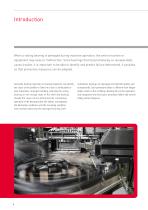
When a rolling bearing is damaged during machine operation, the entire machine or equipment may seize or malfunction. Since bearings that fail prematurely or unexpectedly cause trouble, it is important to be able to identify and predict failure beforehand, if possible, so that preventive measures can be adopted. Generally, bearing inspection or housing inspection can identify the cause of the problem. Often the cause is attributable to poor lubrication, improper handling, selecting the wrong bearing, or not enough study of the shaft and housing. Usually the cause can be determined by...
Open the catalog to page 6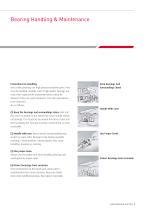
Bearing Handling & Maintenance Precautions for Handling Since rolling bearings are high precision machine parts, they must be handled carefully. Even if high quality bearings are used, their expected life and performance cannot be attained if they are used improperly. The main precautions to be observed are as follows: Keep Bearings And Surroundings Clean! Handle With Care! (1) Keep the bearings and surroundings clean: Dust and dirt, even if invisible to the naked eye, have harmful ef fects on bearings. It is necessary to prevent the entry of dust and dirt by keeping the bearings and their...
Open the catalog to page 7
Bearing Handling & Maintenance Mounting It is advisable to study the bearing mounting thoroughly since the quality of the bearing mounting influences the bearing’s running accuracy, life and performance. It is recommended that the mounting method includes the following steps. › Clean the bearing and surrounding parts. › Check the dimensions and finish conditions of related parts. › Follow mounting procedure. › Check if the bearing is mounted correctly. › Supply with correct kind and quantity of lubricant. It is necessary to periodically inspect and maintain the bearing and its operating...
Open the catalog to page 8
Table 1 Methods to check operation Machine size Manual operation. Turn the bearing by hand. If no problems are detected, then proceed to operate the machine. › Stick-slip (Debris, cracks, dents) › Uneven rotating torque (Faulty mounting) › Excessive torque Check for irregular noise. Check for bearing temperature rise. Lubricant leakage. Discoloration. Idle operation. Turn ON power and allow machine to rotate slowly. Turn OFF the power and allow the bearing to coast to a stop. If no irregularities are detected by the test, then proceed to the loaded rotation testing. Power operation. Follow...
Open the catalog to page 9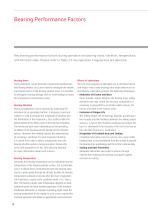
Bearing Performance Factors Key bearing performance factors during operation are bearing noise, vibration, temperature, and lubricant state. Please refer to Table 2 if any operation irregularities are detected. Bearing Noise During operation, sound detection instruments (stethoscope, NSK Bearing Monitor, etc.) can be used to investigate the volume and characteristics of the bearing rotation noise. It is possible to distinguish bearing damage such as small flaking by means of its unusual yet characteristic noise. Bearing Vibration Bearing irregularities can be analyzed by measuring the...
Open the catalog to page 10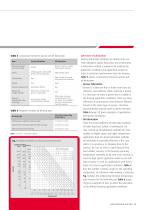
Table 3 Comparison between grease and oil lubrication Item Grease lubrication Housing structure and seal method May be complex. Careful maintenance required. Limiting speed is 65% to 80% of that with oil lubrication High limiting speed Cooling effect Heat transfer is possible using forced oil circulation Lubricant replacement Sometimes difficult Removal of foreign material Removal of particles from grease is impossible External contamination due to leakage Surroundings seldom contaminated by leakage Often leaks if proper counter measures are not taken. Not suitable if external contamination...
Open the catalog to page 11
Bearing Performance Factors Replenishment and Replacement of Lubricant (1) Replenishing Interval Even if high-quality grease is used, there is deterioration of its properties with time; therefore, periodic replenishment is required. Figs. 2 (1) and (2) show the replenishment time intervals for various bearing types running at different speeds. Figs. 2 (1) and (2) apply for the condition of high-quality lithium soap-mineral oil grease, bearing temperature of 70° C, and normal load (P/C=0.1). › Temperature If the bearing temperature exceeds 70° C, the replenishment time interval must be...
Open the catalog to page 12
Table 6 Selection of lubricating oils for different bearing applications Operating temperature Light or normal load Heavy or shock load Below limiting speed Below 50% of limiting speed Between 50% and 100% of limiting speed Above limiting speed Below 50% of limiting speed Between 50% and 100% of limiting speed Above limiting speed Below 50% of limiting speed Between 50% and 100% of limiting speed Above limiting speed Notes: 1. As for the limiting speed, use the value listed under oil lubrication in the Bearing Dimension Tables of “NSK Rolling Bearings” (No. E1102). 2. Refer to refrigerator...
Open the catalog to page 13All NSK Europe Ltd. catalogs and technical brochures
-
TECHNICAL REPORT
302 Pages
-
BEARING DESIGNATION SYSTEMS
48 Pages
-
ROLLING BEARINGS
704 Pages
-
LARGE SIZE ROLLING BEARINGS
564 Pages
-
HA / HS Series
1 Pages
-
NH and NS Series
1 Pages
-
K1
1 Pages
-
K1-L
1 Pages
-
DH/DS Series
1 Pages

